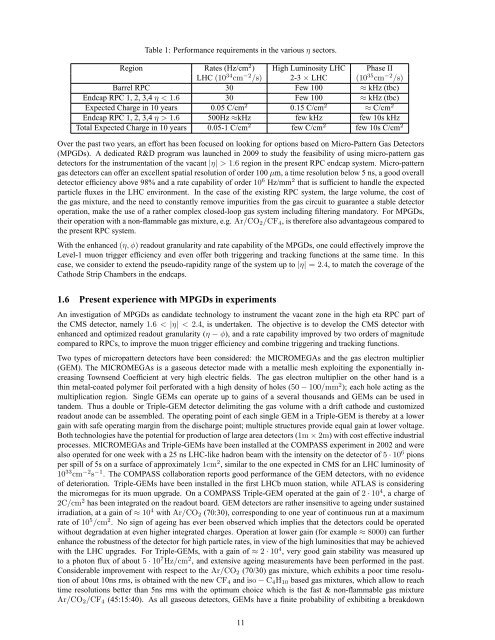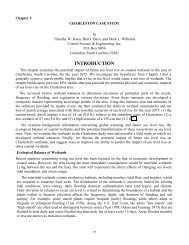A GEM Detector System for an Upgrade of the CMS Muon Endcaps
A GEM Detector System for an Upgrade of the CMS Muon Endcaps
A GEM Detector System for an Upgrade of the CMS Muon Endcaps
Create successful ePaper yourself
Turn your PDF publications into a flip-book with our unique Google optimized e-Paper software.
Table 1: Per<strong>for</strong>m<strong>an</strong>ce requirements in <strong>the</strong> various η sectors.<br />
Region Rates (Hz/cm 2 ) High Luminosity LHC Phase II<br />
LHC (10 34 cm −2 /s) 2-3 × LHC (10 35 cm −2 /s)<br />
Barrel RPC 30 Few 100 ≈ kHz (tbc)<br />
Endcap RPC 1, 2, 3,4 η < 1.6 30 Few 100 ≈ kHz (tbc)<br />
Expected Charge in 10 years 0.05 C/cm 2 0.15 C/cm 2 ≈ C/cm 2<br />
Endcap RPC 1, 2, 3,4 η > 1.6 500Hz ≈kHz few kHz few 10s kHz<br />
Total Expected Charge in 10 years 0.05-1 C/cm 2 few C/cm 2 few 10s C/cm 2<br />
Over <strong>the</strong> past two years, <strong>an</strong> ef<strong>for</strong>t has been focused on looking <strong>for</strong> options based on Micro-Pattern Gas <strong>Detector</strong>s<br />
(MPGDs). A dedicated R&D program was launched in 2009 to study <strong>the</strong> feasibility <strong>of</strong> using micro-pattern gas<br />
detectors <strong>for</strong> <strong>the</strong> instrumentation <strong>of</strong> <strong>the</strong> vac<strong>an</strong>t |η| > 1.6 region in <strong>the</strong> present RPC endcap system. Micro-pattern<br />
gas detectors c<strong>an</strong> <strong>of</strong>fer <strong>an</strong> excellent spatial resolution <strong>of</strong> order 100µm, a time resolution below 5 ns, a good overall<br />
detector efficiency above 98% <strong>an</strong>d a rate capability <strong>of</strong> order 10 6 Hz/mm 2 that is sufficient to h<strong>an</strong>dle <strong>the</strong> expected<br />
particle fluxes in <strong>the</strong> LHC environment. In <strong>the</strong> case <strong>of</strong> <strong>the</strong> existing RPC system, <strong>the</strong> large volume, <strong>the</strong> cost <strong>of</strong><br />
<strong>the</strong> gas mixture, <strong>an</strong>d <strong>the</strong> need to const<strong>an</strong>tly remove impurities from <strong>the</strong> gas circuit to guar<strong>an</strong>tee a stable detector<br />
operation, make <strong>the</strong> use <strong>of</strong> a ra<strong>the</strong>r complex closed-loop gas system including filtering m<strong>an</strong>datory. For MPGDs,<br />
<strong>the</strong>ir operation with a non-flammable gas mixture, e.g. Ar/CO2/CF4, is <strong>the</strong>re<strong>for</strong>e also adv<strong>an</strong>tageous compared to<br />
<strong>the</strong> present RPC system.<br />
With <strong>the</strong> enh<strong>an</strong>ced(η,φ) readout gr<strong>an</strong>ularity <strong>an</strong>d rate capability <strong>of</strong> <strong>the</strong> MPGDs, one could effectively improve <strong>the</strong><br />
Level-1 muon trigger efficiency <strong>an</strong>d even <strong>of</strong>fer both triggering <strong>an</strong>d tracking functions at <strong>the</strong> same time. In this<br />
case, we consider to extend <strong>the</strong> pseudo-rapidity r<strong>an</strong>ge <strong>of</strong> <strong>the</strong> system up to |η| = 2.4, to match <strong>the</strong> coverage <strong>of</strong> <strong>the</strong><br />
Cathode Strip Chambers in <strong>the</strong> endcaps.<br />
1.6 Present experience with MPGDs in experiments<br />
An investigation <strong>of</strong> MPGDs as c<strong>an</strong>didate technology to instrument <strong>the</strong> vac<strong>an</strong>t zone in <strong>the</strong> high eta RPC part <strong>of</strong><br />
<strong>the</strong> <strong>CMS</strong> detector, namely 1.6 < |η| < 2.4, is undertaken. The objective is to develop <strong>the</strong> <strong>CMS</strong> detector with<br />
enh<strong>an</strong>ced <strong>an</strong>d optimized readout gr<strong>an</strong>ularity (η − φ), <strong>an</strong>d a rate capability improved by two orders <strong>of</strong> magnitude<br />
compared to RPCs, to improve <strong>the</strong> muon trigger efficiency <strong>an</strong>d combine triggering <strong>an</strong>d tracking functions.<br />
Two types <strong>of</strong> micropattern detectors have been considered: <strong>the</strong> MICROMEGAs <strong>an</strong>d <strong>the</strong> gas electron multiplier<br />
(<strong>GEM</strong>). The MICROMEGAs is a gaseous detector made with a metallic mesh exploiting <strong>the</strong> exponentially increasing<br />
Townsend Coefficient at very high electric fields. The gas electron multiplier on <strong>the</strong> o<strong>the</strong>r h<strong>an</strong>d is a<br />
thin metal-coated polymer foil per<strong>for</strong>ated with a high density <strong>of</strong> holes (50−100/mm 2 ); each hole acting as <strong>the</strong><br />
multiplication region. Single <strong>GEM</strong>s c<strong>an</strong> operate up to gains <strong>of</strong> a several thous<strong>an</strong>ds <strong>an</strong>d <strong>GEM</strong>s c<strong>an</strong> be used in<br />
t<strong>an</strong>dem. Thus a double or Triple-<strong>GEM</strong> detector delimiting <strong>the</strong> gas volume with a drift cathode <strong>an</strong>d customized<br />
readout <strong>an</strong>ode c<strong>an</strong> be assembled. The operating point <strong>of</strong> each single <strong>GEM</strong> in a Triple-<strong>GEM</strong> is <strong>the</strong>reby at a lower<br />
gain with safe operating margin from <strong>the</strong> discharge point; multiple structures provide equal gain at lower voltage.<br />
Both technologies have <strong>the</strong> potential <strong>for</strong> production <strong>of</strong> large area detectors (1m×2m) with cost effective industrial<br />
processes. MICROMEGAs <strong>an</strong>d Triple-<strong>GEM</strong>s have been installed at <strong>the</strong> COMPASS experiment in 2002 <strong>an</strong>d were<br />
also operated <strong>for</strong> one week with a 25 ns LHC-like hadron beam with <strong>the</strong> intensity on <strong>the</strong> detector <strong>of</strong> 5·10 6 pions<br />
per spill <strong>of</strong> 5s on a surface <strong>of</strong> approximately 1cm 2 , similar to <strong>the</strong> one expected in <strong>CMS</strong> <strong>for</strong> <strong>an</strong> LHC luminosity <strong>of</strong><br />
10 33 cm −2 s −1 . The COMPASS collaboration reports good per<strong>for</strong>m<strong>an</strong>ce <strong>of</strong> <strong>the</strong> <strong>GEM</strong> detectors, with no evidence<br />
<strong>of</strong> deterioration. Triple-<strong>GEM</strong>s have been installed in <strong>the</strong> first LHCb muon station, while ATLAS is considering<br />
<strong>the</strong> micromegas <strong>for</strong> its muon upgrade. On a COMPASS Triple-<strong>GEM</strong> operated at <strong>the</strong> gain <strong>of</strong> 2·10 4 , a charge <strong>of</strong><br />
2C/cm 2 has been integrated on <strong>the</strong> readout board. <strong>GEM</strong> detectors are ra<strong>the</strong>r insensitive to ageing under sustained<br />
irradiation, at a gain <strong>of</strong> ≈ 10 4 with Ar/CO2 (70:30), corresponding to one year <strong>of</strong> continuous run at a maximum<br />
rate <strong>of</strong> 10 5 /cm 2 . No sign <strong>of</strong> ageing has ever been observed which implies that <strong>the</strong> detectors could be operated<br />
without degradation at even higher integrated charges. Operation at lower gain (<strong>for</strong> example ≈ 8000) c<strong>an</strong> fur<strong>the</strong>r<br />
enh<strong>an</strong>ce <strong>the</strong> robustness <strong>of</strong> <strong>the</strong> detector <strong>for</strong> high particle rates, in view <strong>of</strong> <strong>the</strong> high luminosities that may be achieved<br />
with <strong>the</strong> LHC upgrades. For Triple-<strong>GEM</strong>s, with a gain <strong>of</strong> ≈ 2·10 4 , very good gain stability was measured up<br />
to a photon flux <strong>of</strong> about 5·10 7 Hz/cm 2 , <strong>an</strong>d extensive ageing measurements have been per<strong>for</strong>med in <strong>the</strong> past.<br />
Considerable improvement with respect to <strong>the</strong> Ar/CO2 (70/30) gas mixture, which exhibits a poor time resolution<br />
<strong>of</strong> about 10ns rms, is obtained with <strong>the</strong> new CF4 <strong>an</strong>d iso−C4H10 based gas mixtures, which allow to reach<br />
time resolutions better th<strong>an</strong> 5ns rms with <strong>the</strong> optimum choice which is <strong>the</strong> fast & non-flammable gas mixture<br />
Ar/CO2/CF4 (45:15:40). As all gaseous detectors, <strong>GEM</strong>s have a finite probability <strong>of</strong> exhibiting a breakdown<br />
11
















